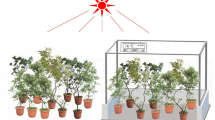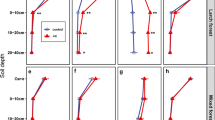Summary
Trees at high elevations are exposed to a combination of high irradiance, extreme climate and increasingly higher ozone concentrations. As a defense, trees are equipped with an antioxidative system protecting them from reactive oxygen species (ROS) induced directly (by e. g. ozone) or via interaction of stress with primary plant metabolism. Although the effect of high elevation stress on growth and the antioxidative metabolism of spruce (Picea abies [L.] Karst.) has been studied widely, very little information exists for European larch trees (Larix decidua Mill.). Therefore, we investigated the content of the antioxidants glutathione, ascorbate and tocopherol, and of photoprotective pigments of larch needles growing at valley (1000 m a. s. l.) and timberline (2000 m) stands of the northern (Austrian) and southern (Italian) Limestone Alps. The glutathione content of larch needles increased with elevation in the northern and southern Alps. Larch needles contained higher contents of oxidized glutathione at all high elevation sites. In addition, the glutathione content in larch needles of the southern Alps was higher than that in the north, suggesting a higher antioxidant defence capacity. In the Austrian Alps, the ascorbate content increased with elevation. Xanthophylls in larch needles grown at the timberline were in a more de-epoxidized state than those from lower elevation. Our study points out that the protective systems of larch needles along elevational gradients are largely comparable to evergreen conifers. Foliar biochemical attributes of larch can be used as a system to monitor the stress status of trees.
Zusammenfassung
Bäume, die an der Waldgrenze wachsen, sind einer Kombination aus hoher Strahlung, extremem Klima und höherer Ozonkonzentrationen ausgesetzt. Sie sind mit einem antioxidativen Schutzsystem ausgerüstet, das sie vor der Einwirkung der reaktiven Sauerstoffspezies (ROS) bewahrt. Obwohl die Auswirkungen von Höhenstresss auf Wachstum und Stoffwechsel von Fichten genau untersucht wurden, existieren wenige Untersuchungen über die Lärche. Deshalb wurde in dieser Studie der Gehalt der Antioxidantien Glutathion, Ascorbinsäure und Tocopherol, sowie der Lichtschutzpigmente von Lärchen aus Tal- und Höhenlagen (1000 bzw. 2000 m) der österreichischen (nördlichen) und italienischen (südlichen) Kalkalpen untersucht. Der Glutathiongehalt in den Lärchennadeln beider Länder stieg mit der Seehöhe an. Ausserdem wiesen Nadeln der Höhenlagen höhere Anteile an oxidiertem Glutathion auf. In Nadeln der österreichischen Standorte sank der Ascorbinsäuregehalt mit zunehmender Höhe. Die Xanthophylle der Höhenlagen-Lärchen befanden sich in einem höher de-epoxidierten Zustand als jene der Tallagen. Unsere Studie belegt, dass die Schutzsysteme von Lärchen entlang eines Höhenprofils vergleichbar mit denen immergrüner Koniferen sind. Somit können biochemische Eigenschaften von Lärchennadeln als geeignete Systeme zur Bewertung der Stressbelastung von Bäumen verwendet werden.
Similar content being viewed by others
Abbreviations
- A:
-
antheraxanthin
- Asc:
-
Ascorbate
- DHAsc:
-
Dehydroascorbate
- GSH:
-
glutathione
- GSSG:
-
oxidized glutathione
- PPFD:
-
Photosynthetic photon flux density
- ROS:
-
reactive oxygen species
- V:
-
violaxanthin
- Z:
-
zeaxanthin
Author information
Authors and Affiliations
Corresponding author
Additional information
1 former (geb.) Tegischer
Rights and permissions
About this article
Cite this article
Hecke1, K., Tausz, M., Gigele, T. et al. Foliar Antioxidants and Protective Pigments in Larix decidua Mill. from Contrasting Elevations in the Northern and Southern Tyrolean Limestone Alps. Forstwissenschaftliches Centralblatt vereinigt mit Tharandter Forstliches Jahrbuch 122, 368–375 (2003). https://doi.org/10.1007/s10342-003-0005-2
Received:
Accepted:
Issue Date:
DOI: https://doi.org/10.1007/s10342-003-0005-2




